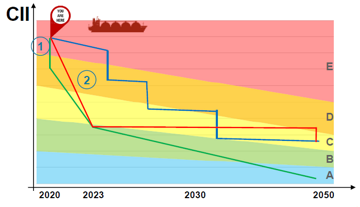 EEXI and CII 16.01.2022 18:13
EEXI and CII 16.01.2022 18:13On 17June 2021 (MEPC 76), the International Maritime Organization (IMO) adopted amendments to MARPOL Annex VI, based on changes drafted at MEPC 75 in November 2020. This consists of new regulations 23 and 25 – the introduction of the Energy Efficiency Existing Ship Index (EEXI) and regulation 28 - the requirement to demonstrate operational carbon intensity reduction through the Carbon Intensity Indicator (CII). These will enter into force on 01 November 2022.
While the EEXI is a one-time certification targeting design parameters, the CII addresses the actual emissions in operation.
Energy Efficiency Existing Ship Index (EEXI)
EEXI regulation applies to ships of 400 gross tonnage and above, and whose ship type falls into one or more of the categories* in regulation 2 of MARPOL Annex VI. Ships to which the regulation applies will be required to calculate EEXI value of each individual ship (i.e. attained EEXI) and the value shall be equal to or less than the allowable maximum value (i.e. required EEXI). Furthermore, if attained EEXI cannot satisfy the required EEXI, the ship should implement any countermeasures, such as shaft/engine power limitation, retrofitting energy saving devices, etc.
The certification of EEXI (i.e. revising International Energy Efficiency (IEE) Certificate) will take place at the first annual, intermediate or renewal survey of the International Air Pollution Prevention (IAPP) Certificate on or after 1st January 2023 for ships delivered before 1st January 2023, or at the initial survey of IEE Certificate for ships delivered on or after 1st January 2023. The verification of EEXI shall be completed by the date of the survey.
Short-term measures are meant to be set into force by 2023. Different measures were considered and widely discussed, and IMO has decided to introduce a combination of technical and operational measures. Whereas the EEXI is the technical measure, just looking at the design of the ship in comparable way as the EEDI does for newbuidlings, the CII is the according operational measure considering the actual consumption and distance travelled for each individual ship in service.
IBICON can help with the following:
- If you have not yet commenced your EEXI calculations, we recommend starting now to ensure plenty of time for potential improvements and statutory approval before the deadline
- If you have already completed calculations for your fleet, you should ensure that these are still applicable and arrange for the calculated attained EEXI (and OPL impacts) to be updated where required
- Once a compliant EEXI has been attained, you can progress compilation of your Technical Files and Onboard Management Manuals (where applicable) and then progress with statutory approval
Carbon Intensity Indicator (CII)
The IMO introduced the Carbon Intensity Indicator (CII) regulations at the MEPC 76 in June 2021. Now, about six months after they were adopted, we want to share with you some key takeaways on what we have so far learnt about implementing the CII in this statutory news.
From 2023, the CII requirements will take effect for all cargo, RoPax and cruise vessels above 5,000 GT and trading internationally. The CII measures how efficiently a ship transports goods or passengers and is given in grams of CO2 emitted per cargo-carrying capacity and nautical mile. The ship is then given an annual rating ranging from A to E, whereby the rating thresholds will become increasingly stringent towards 2030.


